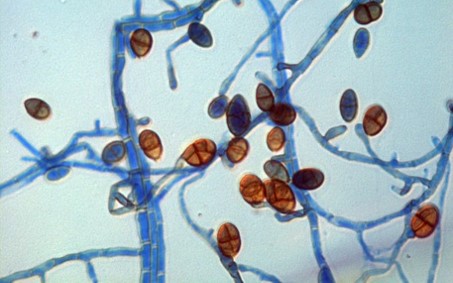What influences mycotoxin formation?
A considerable part of the annual world harvest is contaminated with fungal toxins, so-called mycotoxins, and should therefore be discarded. It is foreseeable that the spread and resistance of fungi will increasingly affect food production and consumer health in the future. Last but not least, climate changes are leading to increased infestation of crops by harmful organisms.
Important fungal pests on crops are in particular representatives of the species Fusarium, Aspergillus and Alternaria. In addition to the toxic effect of the mycotoxins frequently formed by these fungal genera, spore proteins of black fungi such as Alternaria are considered strong antigens and can trigger so-called "mycogenic allergies" when consumed or in repeated contact through inhalation and touch. Only comprehensive scientific research will answer as yet unanswered questions about the genetic regulation of mycotoxin formation in Alternaria fungi. Based on the investigations of the MRI and other research institutions, knowledge-based legal limit values can be recommended in the future.
Fungi of the genus Alternaria cause about 400 different plant diseases on apples, grapes, onions, tomatoes, potatoes, citrus fruits, and various cereals, among others. Contamination with mycotoxins from Alternaria infestation occurs both already in the field and after harvest, i.e. during storage of food or produce under conditions that favor fungal growth and mycotoxin formation. More than 70 toxins produced by fungi of the genus Alternaria that can harm human and animal health are known to date.
The broad host range of some Alternaria species is an indication of the high adaptability of this fungal genus. The ability to survive and adapt to a host depends to a large extent on the capacity of a fungal species to biosynthesize a broad spectrum of metabolites. Thus, a current hypothesis is that secondary metabolites act as a biochemical "toolbox" of the producing microorganism that supports and promotes its ability to resist and adapt to a host or habitat.
Keeping this in mind, it makes sense that physicochemical factors such as light, pH, temperature, substrate composition, and water activity, which have a major impact on the growth and metabolism of filamentous fungi, are tightly controlled at the cellular level. In this context, the Department Safety and Quality of Fruit and Vegetables is investigating whether Alternaria isolates adapted to a specific habitat have a specific genetic makeup for the biosynthesis of secondary metabolites that allows them, for example, to specifically compensate for hostile conditions and compete with other microorganisms.
Tomatoes and apples, as well as cereals such as wheat, are typical substrates for Alternaria. These plants represent either drier (wheat) or wetter (tomatoes, apples) habitats. Alternaria grows well in both cases, which implies successful adaptation to drought stress. Previous research by the Max Rubner-Institut showed a strong influence of water activity, i.e. the water available in a food, on the growth and mycotoxin formation of Alternaria alternata. The influence on other food-relevant mycotoxins, such as altertoxin and tenuazonic acid, is currently being extensively investigated. It is expected that A. alternata isolates from fruits and vegetables will adapt differently to different moisture conditions compared to isolates found on relatively dry host plants, such as wheat and other cereals. Early work by the Max Rubner-Institut on Alternaria, and later in collaboration with KIT (Karlsruhe Institute of Technology), also showed that the mycotoxin alternariol produced by A. alternata helps the fungus colonize tomatoes more easily.
Other factors or metabolites that contribute to the pathogenicity and virulence of Alternaria have been less studied. Often toxin formation is not directly related to growth rate; consequently, fungal growth alone cannot act as a marker for active mycotoxin formation. On the other hand, the pathogenicity of many fungal species is associated with the excretion of certain secondary metabolites. An exciting discovery is that alternariol and also other mycotoxins can be further metabolized and thus "masked" by the fungus itself. In the current project, the gene responsible for this, a possible sulfotransferase, is being identified and characterized in the genome of Alternaria. The functional significance of sulfatation of Alternariol in the interaction of the fungus with the plant is being investigated via silencing of this gene using molecular biology methods. The project is also looking at altertoxin, which is produced by Alternaria on tomatoes and apples, for example, and may play a similarly important role as alternariol.
The Department of Safety and Quality of Fruit and Vegetables is addressing the research questions presented here in a multidisciplinary approach, thereby expanding the data base to enable better risk assessment and informed policy advice on this topic. Based on the results, sustainable, biological prevention strategies against fungal diseases are developed, among other things.


